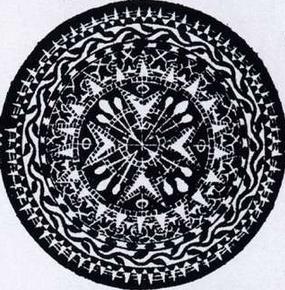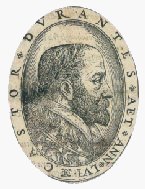|
Leonardo Parasole
Leonardo Parasole (born c. 1570) was an Italian engraver on wood of the late-Mannerist and early-Baroque periods. He was born and remained in Rome throughout his life. Parasole designed cuts for the Herbal book written by Castore Durante, physician to Pope Sixtus V. He also engraved the wood-cuts to a ''Testamentum novnm, arabice et latine and several prints from the designs of Antonio Tempesta, including an ''Annunciation''. Personal life Parasole married the engraver Isabella Parasole, and discarded his original last name, ''Norsini'' or ''Norcino'', in favor of his wife's more distinguished last name. His son, Bernardino Parasole Bernardino Parasole (c. 17th century) was an Italian painter of the Baroque period. He was born to the painters Isabella and Leonardo Parasole, but then apprenticed with Giuseppe Cesari Giuseppe Cesari (14 February 1568 – 3 July 1640) was a ..., was also an engraver and painter. References * 1570s births Italian engravers Italian ... [...More Info...] [...Related Items...] OR: [Wikipedia] [Google] [Baidu] |
Rome
, established_title = Founded , established_date = 753 BC , founder = King Romulus (legendary) , image_map = Map of comune of Rome (metropolitan city of Capital Rome, region Lazio, Italy).svg , map_caption = The territory of the ''comune'' (''Roma Capitale'', in red) inside the Metropolitan City of Rome (''Città Metropolitana di Roma'', in yellow). The white spot in the centre is Vatican City. , pushpin_map = Italy#Europe , pushpin_map_caption = Location within Italy##Location within Europe , pushpin_relief = yes , coordinates = , coor_pinpoint = , subdivision_type = Country , subdivision_name = Italy , subdivision_type2 = Region , subdivision_name2 = Lazio , subdivision_type3 = Metropolitan city , subdivision_name3 = Rome Capital , government_footnotes= , government_type = Strong Mayor–Council , leader_title2 = Legislature , leader_name2 = Capitoline Assemb ... [...More Info...] [...Related Items...] OR: [Wikipedia] [Google] [Baidu] |
Italy
Italy ( it, Italia ), officially the Italian Republic, ) or the Republic of Italy, is a country in Southern Europe. It is located in the middle of the Mediterranean Sea, and its territory largely coincides with the homonymous geographical region. Italy is also considered part of Western Europe, and shares land borders with France, Switzerland, Austria, Slovenia and the enclaved microstates of Vatican City and San Marino. It has a territorial exclave in Switzerland, Campione. Italy covers an area of , with a population of over 60 million. It is the third-most populous member state of the European Union, the sixth-most populous country in Europe, and the tenth-largest country in the continent by land area. Italy's capital and largest city is Rome. Italy was the native place of many civilizations such as the Italic peoples and the Etruscans, while due to its central geographic location in Southern Europe and the Mediterranean, the country has also historically been home ... [...More Info...] [...Related Items...] OR: [Wikipedia] [Google] [Baidu] |
Isabella Parasole
Isabella Parasole (ca. 1570 – ca. 1620) was an Italian engraver and woodcutter of the late-Mannerist and early-Baroque periods. She was born and active in Rome. She married the engraver Leonardo Norsini, who took his wife's more distinguished last name. Her sister, Geronima Parasole, was also an engraver and made a woodcut of Antonio Tempesta's ''Battle of the Centaurs''. Isabella executed several cuts of plants for an herbal, published under the direction of Federico Cesi, of Acquasparta. She published a book in 1597 called ''Studio delle Virtuose Dame'', dedicated to Juana de Aragón y Cardona (1575–1608), and in 1616 she published another book on the methods of working lace and embroidery, with ornamental cuts, which she engraved from her own designs. She dedicated that book to Elisabeth of France (1602–1644), and called herself also Elisabetta as the author. Her son Bernardino Parasole became a pupil of Giuseppe Cesari, but died young. She was working at Rome about 160 ... [...More Info...] [...Related Items...] OR: [Wikipedia] [Google] [Baidu] |
Bernardino Parasole
Bernardino Parasole (c. 17th century) was an Italian painter of the Baroque period. He was born to the painters Isabella and Leonardo Parasole, but then apprenticed with Giuseppe Cesari Giuseppe Cesari (14 February 1568 – 3 July 1640) was an Italian Mannerist painter, also named Il Giuseppino and called ''Cavaliere d'Arpino'', because he was created ''Cavaliere di Cristo'' by his patron Pope Clement VIII. He was much patronize .... Bernardino died young. References * 17th-century Italian painters Italian male painters Italian Baroque painters Year of death unknown Year of birth unknown {{Italy-painter-17thC-stub ... [...More Info...] [...Related Items...] OR: [Wikipedia] [Google] [Baidu] |
Mannerist
Mannerism, which may also be known as Late Renaissance, is a style in European art that emerged in the later years of the Italian High Renaissance around 1520, spreading by about 1530 and lasting until about the end of the 16th century in Italy, when the Baroque style largely replaced it. Northern Mannerism continued into the early 17th century. Mannerism encompasses a variety of approaches influenced by, and reacting to, the harmonious ideals associated with artists such as Leonardo da Vinci, Raphael, Vasari, and early Michelangelo. Where High Renaissance art emphasizes proportion, balance, and ideal beauty, Mannerism exaggerates such qualities, often resulting in compositions that are asymmetrical or unnaturally elegant.Gombrich 1995, . Notable for its artificial (as opposed to naturalistic) qualities, this artistic style privileges compositional tension and instability rather than the balance and clarity of earlier Renaissance painting. Mannerism in literature and music is not ... [...More Info...] [...Related Items...] OR: [Wikipedia] [Google] [Baidu] |
Baroque
The Baroque (, ; ) is a style of architecture, music, dance, painting, sculpture, poetry, and other arts that flourished in Europe from the early 17th century until the 1750s. In the territories of the Spanish and Portuguese empires including the Iberian Peninsula it continued, together with new styles, until the first decade of the 19th century. It followed Renaissance art and Mannerism and preceded the Rococo (in the past often referred to as "late Baroque") and Neoclassical styles. It was encouraged by the Catholic Church as a means to counter the simplicity and austerity of Protestant architecture, art, and music, though Lutheran Baroque art developed in parts of Europe as well. The Baroque style used contrast, movement, exuberant detail, deep colour, grandeur, and surprise to achieve a sense of awe. The style began at the start of the 17th century in Rome, then spread rapidly to France, northern Italy, Spain, and Portugal, then to Austria, southern Germany, and Russia. B ... [...More Info...] [...Related Items...] OR: [Wikipedia] [Google] [Baidu] |
Herbal
A herbal is a book containing the names and descriptions of plants, usually with information on their medicinal, tonic, culinary, toxic, hallucinatory, aromatic, or magical powers, and the legends associated with them.Arber, p. 14. A herbal may also classify the plants it describes, may give recipes for herbal extracts, tinctures, or potions, and sometimes include mineral and animal medicaments in addition to those obtained from plants. Herbals were often illustrated to assist plant identification.Anderson, p. 2. Herbals were among the first literature produced in Ancient Egypt, China, India, and Europe as the medical wisdom of the day accumulated by herbalists, apothecaries and physicians. Herbals were also among the first books to be printed in both China and Europe. In Western Europe herbals flourished for two centuries following the introduction of moveable type (c. 1470–1670). In the late 17th century, the rise of modern chemistry, toxicology and pharmacology reduced ... [...More Info...] [...Related Items...] OR: [Wikipedia] [Google] [Baidu] |
Castore Durante
Castore Durante, also called Castor Durante da Gualdo (Gualdo Tadino, 1529 – Viterbo, 1590) was a physician, botanist and poet of the Italian Renaissance. His father was the jurist Giovan Diletto Durante. He had five siblings, including a brother named Pollùce (Pollux). He graduated in medicine at Perugia in 1567 and practiced as a doctor in Gualdo Tadino. He later taught at the "Archiginnasio della Sapienza" (now called the Sapienza University of Rome) and, on the recommendation of Cardinal Girolamo Rusticucci, was appointed chief physician at the court of Pope Sixtus V. He died at Viterbo in 1590 and was buried in the church of the Franciscan monastery. Major works *''Herbario Nuovo'', published in 1585, is a description of medicinal plants from Europe and the Indies (East and West). The first editions were illustrated by Leonardo Parasole da Norcia (fl.1570), while the third edition contains woodcuts by his wife, the engraver Isabella Parasole. Each species includes discu ... [...More Info...] [...Related Items...] OR: [Wikipedia] [Google] [Baidu] |
Pope Sixtus V
Pope Sixtus V ( it, Sisto V; 13 December 1521 – 27 August 1590), born Felice Piergentile, was head of the Catholic Church and ruler of the Papal States from 24 April 1585 to his death in August 1590. As a youth, he joined the Franciscan order, where he displayed talents as a scholar and preacher, and enjoyed the patronage of Pius V, who made him a cardinal. As a cardinal, he was known as Cardinal Montalto. As Pope, he energetically rooted out corruption and lawlessness across Rome, and launched a far-sighted rebuilding programme that continues to provoke controversy, as it involved the destruction of antiquities. The cost of these works was met by heavy taxation that caused much suffering. His foreign policy was regarded as over-ambitious, and he excommunicated both Queen Elizabeth I of England and King Henry IV of France. He is recognized as a significant figure of the Counter-Reformation. He is the most recent pope to date to take on the pontifical name "Sixtus". Early li ... [...More Info...] [...Related Items...] OR: [Wikipedia] [Google] [Baidu] |
Antonio Tempesta
Antonio Tempesta, also called il Tempestino (1555 – 5 August 1630), was an Italian painter and engraver, whose art acted as a point of connection between Baroque Rome and the culture of Antwerp. Much of his work depicts major battles and historical figures. Life He was born and trained in Florence and painted in a variety of styles, influenced to some degree by "Counter-''Maniera''" or Counter-Mannerism. He enrolled in the Florentine Accademia delle Arti del Disegno in 1576. He was a pupil of Santi di Tito, then of the Flemish painter Joannes Stradanus. He was part of the large team of artists working under Giorgio Vasari on the interior decoration of the Palazzo Vecchio in Florence. His favourite subjects were battles, cavalcades, and processions. He relocated to Rome, where he associated with artists from the Habsburg Netherlands, which may have led to his facility with landscape painting. Among his followers was Marzio di Colantonio. Commissions Tempesta and the F ... [...More Info...] [...Related Items...] OR: [Wikipedia] [Google] [Baidu] |
1570s Births
Year 157 ( CLVII) was a common year starting on Friday (link will display the full calendar) of the Julian calendar. At the time, it was known as the Year of the Consulship of Civica and Aquillus (or, less frequently, year 910 ''Ab urbe condita''). The denomination 157 for this year has been used since the early medieval period, when the Anno Domini calendar era became the prevalent method in Europe for naming years. Events By place Roman Empire *A revolt against Roman rule begins in Dacia. Births * Gaius Caesonius Macer Rufinianus, Roman politician (d. 237) * Hua Xin, Chinese official and minister (d. 232) * Liu Yao, Chinese governor and warlord (d. 198) * Xun You Xun You (157–214), courtesy name Gongda, was a statesman who lived during the late Eastern Han dynasty of China and served as an adviser to the warlord Cao Cao. Born in the influential Xun family of Yingchuan Commandery (around present- ..., Chinese official and statesman (d. 214) Deat ... [...More Info...] [...Related Items...] OR: [Wikipedia] [Google] [Baidu] |





